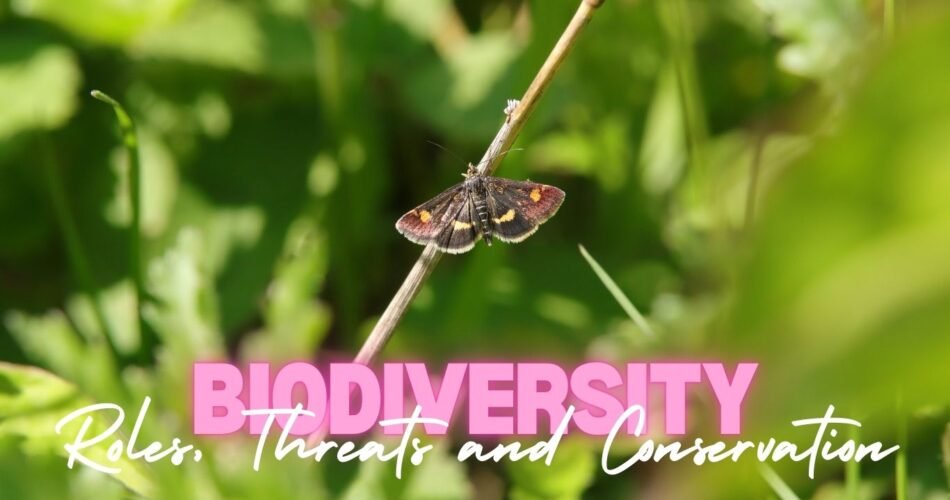This blog provides information about Biodiversity. In the start it introduces and defines Biodiversity in detail. Then it shines a light on Roles of Biodiversity in Nature and on Earth. It also explains the Threats to Biodiversity in detail. In the end, It elaborates the Conservation Strategies for Biodiversity in brief form. This blog contains Biodiversity Roles, Threats and Conservation.
What is Biodiversity?
Biodiversity is the variety of different kinds of life found on Earth. It includes every type of life such as animals, birds, insects, plants and every living organism on the planet. Biodiversity is part of the Biotic part of the environment because it contains every living thing.
It is very important for the environment as every type of life found on Earth plays its own role in maintaining and balancing the environment. The natural processes involved in keeping the Earth’s environment alive. Including the Earth’s Self Healing mechanism, every geological cycle of the Earth need specific organisms to carry out certain processes.
The forests and other green spaces are stabilized with the help of living organisms. These organisms includes Microorganisms, plants, animals, insects and other minor animals that have their own role in maintaining the Nutrient Balance and Natural Environments of green spaces, gardens and forests.
Every type of biodiversity exists because of some specific roles of them in nature and environment. Without Biodiversity the world cannot exist. For example, plants makes oxygen and absorbs CO2 from the environment, microorganisms decompose dead organic matter and dead organic matter serves as the natural fertilizer for the soil etc.
This blog will tell you about the Roles, Threats and Conservation of Biodiversity in our lives and for Earth. This will guide of about different roles that biodiversity play to maintain and keep the Earth alive and boosted.
Roles of Biodiversity in Nature:
There are many important roles of biodiversity in maintaining the nature. They are the reason we can live on Earth. Some of the important roles of Biodiversity are explained in this Blog.
Production of Oxygen:
As we all know that, most of the living organisms relies on oxygen for living and surviving in the environment. Trees are the most important and significant producers of oxygen. They emit oxygen from the leaves and add it in the atmosphere. It also absorbs CO2 from the atmosphere, that is one of the major air pollutants on Earth. Trees not only produce oxygen, but also cleanse the air in which we breathe and live. That is why, the production of oxygen is a huge contribution in the Earth’s environment. As Earth is a living planet because of presence of Oxygen.

Pollination of Plants:
Pollination is the a very important process in plant’s life. This is the process of transfer of pollen grains from one place to another. This is very important in natural dispersion of seeds in the green fields and gardens. This process is completely dependent on insects that have sticky body. Their sticky body takes the seeds sticking to them and then throw randomly into the gardens and green spaces. In this way flowers and plants are are grown naturally at random locations. This process is very important in plant development and natural mechanism of plant growth.
Resilience of Ecosystem:
The different varieties of living organisms living in the same area and same ecosystem, have different ways of life and adaptations. The varieties of living organisms in one region makes the ecosystem more rigid because the organisms lives with their contributions such as cleaning the air, decomposition process, building up their habitats etc. The ecosystem is strengthened when many different varieties of living organisms lives in the same area.
Pest Control:
Pests are the insects and other small animals that cause damage to the plants, crops or any type of greenery so these can cause destruction and disturbance in growth of crops. If no control measures are used, they can destroy all the efforts practices to raise the crops. Biodiversity helps us in pest control processes. As we know that small insects are food for animals life frogs, birds, some mammals and many other organisms. They eat all the dangerous insects and protect the field or crops from damaging.
Economic Benefits:
Biodiversity provides us a wide range of raw material for industrial activities, construction, manufacturing and daily life use. This raw material includes wood form the trees, medicinal plants, animals skin, herbs, shrubs, and also many other raw materials used in different industries of the world. Biodiversity also provide us materials to study for different fields. These materials includes organic substances, body parts, human and animal body to study, suitable infrastructure and many more such materials.
Recreation:
Biodiversity contains most of the animals and plants that are worth watching so these varieties of life serves as great recreation for the humans in many ways. We can enjoy the biodiversity in National Parks, Huge Aquariums, Zoos, Forests and many other associated locations where living materials and organisms lives. People who love animals, spend most of their time with animals either in national parks, in zoo or by petting them at home. Some friendly Animals have a good relation with humans. These animals include cats, dogs, fishes, rabbits, pandas etc.
These are the roles of Biodiversity on Earth.
Threats to Biodiversity:
Following are some of the threats to Biodiversity:
1. Climate Change:
Human Activities have made the natural phenomenon of Climate Change extremely accelerated. Industrialization era have added many toxic and harmful pollutants to the atmosphere. This has increased the Global warming that effects the humans and other biodiversity at great extents. Many animals and humans gets different diseases and faces deaths because of Climate change and Extreme Climatic events. This has caused destruction of biodiversity at great levels.
2. Deforestation:
Most of the rare and valuable biodiversity lives in forests. Humans are cutting these forests for industrial use and commercial use. We can call it as deforestation. Deforestation is causing disturbance in natural environment of forests and also removing the nutrients in forest soil. This not only cause destruction of trees but also cause damaging of habitats of flora and fauna of rare kinds. That is why, deforestation is a huge threat to Biodiversity.
3. Pollution:
Increase in human population is the increase in pollution of every kind. This pollution can be land pollution, water pollution, air pollution and noise pollution. All of these pollutions effect the living and survival of biodiversity. Their habitats are destroyed, their living environments are polluted and sometimes they have to be exposed to environmental hazards due to polluted habitats. In this way pollution is causing death and damage to all types of biodiversity on Earth.
4. Over-exploitation of Species:
Over exploitation means over-use and over-consumption of certain species around the world. Some of the species of plants and animals are famous as food, so they are harvested or utilized by humans at great levels and eventually they are endangered or become extinct. In the same way the species of animals admired by humans as their pets, are highly consumed by people and they become rare in some time. In this way over exploitation cause the extinction of the species of plants and animals.
5. Invasive Species:
Invasive species are the group of species that are non-native and are harmful or a threat to native species. These species may be in plants and animals. These species enters an ecosystem and destroy all other species that are native and found in certain ecosystem so they can disturb the normal functioning of the native species and cause destruction of the natural environment of that region or area. These can even cause death or decay of native species.
These are few threats to Biodiversity on Earth. This blog contains Roles, Threats and Conservation of Biodiversity in detail.
Conservation of Biodiversity:
Following are some Conservation Strategies of Biodiversity:
Habitat Conservation:
Human activities are destroying the habitats of species of animals and plants through anthropogenic activities. We should conserve our forests, keep our water resources clean and habitable, and protect animals from environmental hazards to conserve them.
Establish National Parks:
National Parks are set up to provide proper habitats to species of plants and animals away from human activities. By establishing National parks, we can save them from negative impacts of the environment and humans at the same time.
Breeding of Suitable Animals and Plants:
Science has progressed enough to achieve breeding techniques of suitable and valuable plants and animals on Earth. This will help in increasing the population of animals and also plants that are suitable and useful for maintenance of our natural environment.
Save Endangered Species:
Endangered species are the group of species that are near to extinct. These species are weaker and may die very easily in normal environments so they should be kept in specialized environments away from human activities and environmental hazards to increase their population and conserve them.
Protect Native Species:
Native species play a great role in regulating and building resilience to the ecosystem of the specific region. These species should be protected from invasive species so that the ecosystem does not get disturbed. Invasive species should be monitored and attacked before any damage to native species.
Adoption of Sustainable Ways:
We should try to adopt modern and sustainable ways to use resources related to biodiversity so we should replant and re-establish these resources for the future generations. The rehabilitating of such resources includes reforestation, restoration of wetlands, afforestation, pollution control etc.
These are some of the Conservation Strategies for Biodiversity. This blog contains Roles, Threats and Conservation of Biodiversity in detail.

To learn about more topics, click the links below:


Comments